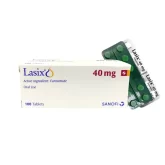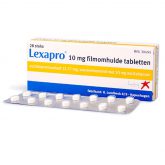Description
Understanding Paxil: Uses, Dosage, Side Effects, and Warnings
Paxil, also known as paroxetine, is an antidepressant medication in the selective serotonin reuptake inhibitor (SSRI) class. In this article, we will discuss the various uses, side effects, warnings, and drug interactions of Paxil.
Uses
Sleep disturbance, loss of interest or pleasure, guilt or worthlessness, low energy, trouble focusing, altered appetite or weight, motor dysfunction, suicidal ideation, and low mood are all symptoms of depression that a lack of serotonin can cause. The active ingredient in Paxil is paroxetine, which is an SSRI that increases the levels of serotonin in the brain.
Aside from major depressive disorder, doctors can prescribe Paxil for other conditions, such as generalized anxiety disorder, obsessive-compulsive disorder (OCD), panic disorder, social anxiety disorder or social phobia, and post-traumatic stress disorder (PTSD). Paxil can also help relieve hot flashes and night sweats during menopause. However, doctors usually do not recommend that children or adolescents under 18 years old use Paxil, except for those with OCD and social anxiety disorder.
It is essential to work closely with a healthcare provider to determine if Praxil is the right medication for your specific needs and to monitor for any potential side effects.
Dosage of Paxil
Paxil comes in three different forms for oral consumption, including immediate-release tablets, oral suspension, and controlled-release tablets (Paxil CR). The appropriate dosage of Paxil prescribed by a doctor varies based on the condition being treated. Initially, doctors may recommend a starting dose and make adjustments based on the patient’s symptoms and side effects.
For major depressive disorder, both immediate-release and controlled-release tablets can be used. Doctors usually start adults on 20 mg of immediate-release Paxil once a day, and for older adults, 10 mg once daily.
For generalized anxiety disorder, immediate-release tablets of Paxil are recommended, with a starting and continued dose of 20 mg per day. There is no proof that more benefits can be gained from taking a higher dose.
When treating OCD, immediate-release tablets of Paxil are typically chosen, with adults starting on 20 mg per day and increasing by 10 mg per day at weekly intervals. The recommended continued daily dose is 40 mg, with a maximum of 60 mg daily.
For PTSD, immediate-release Paxil is used to relieve symptoms, and adults usually start on 20 mg per day, with a maximum dose of 50 mg. For older adults, the starting dose may be 10 mg per day, with a maximum of 40 mg.
Side Effects of Paxil
Like any medication, Paxil can cause side effects ranging from mild to severe. The most common side effects of Paxil are sleeplessness, anxiety, nausea, diarrhea, flatulence, impotence, and abdominal pain. However, these side effects usually go away on their own after a few days or weeks of taking the medication.
Serious side effects of Paxil may include suicidal thoughts or actions, serotonin syndrome, severe allergic reactions, abnormal bleeding, seizures or convulsions, episodes of mania, changes in appetite or weight, and a decrease in sodium levels. Do not wait; contact your GP if you notice any of these side effects.
Warnings
The FDA warns that Paxil may increase the risk of suicidal thoughts or actions, especially in children, adolescents, and young adults. However, research has not shown this effect in individuals over 24 years old. Before prescribing Paxil to anyone under 24, doctors will weigh the potential risks and benefits. If someone experiences any changes in their mood, thoughts, or feelings after starting Paxil, they should inform their doctor immediately. Pregnant women should not take Paxil because it may increase the risk of heart-related congenital disabilities in infants exposed during the first trimester. It may also pass into breast milk, so it is essential to speak to a doctor before taking Paxil while breastfeeding.










Reviews
There are no reviews yet.